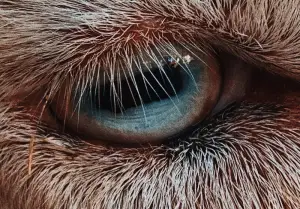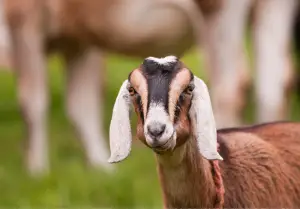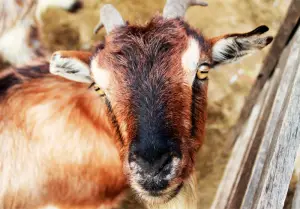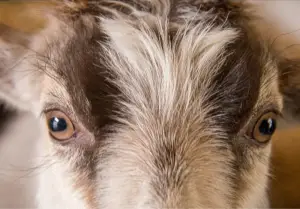How Goats See | Goat Eyesight Guide
If you’ve ever looked into the eyes of a goat, you may have found yourself wondering how their vision differs from your own. The vision of a goat differs in many ways from that of a human’s, and the reasons for the variation all come down to their lifestyle and how they have evolved.
How do goats see, and how is their vision unique? Goats have generally good eyesight. They are dichromatic with the ability to see a limited range of colors, they are able to see well in the dark due to their ability to control the light that enters their eyes, and they have one of the most impressive fields of vision in the animal kingdom.
If you are interested in the fascinating eyesight of the goat, read on for more facts about goat vision and why their eyes have evolved the way they have.
What Is So Unique About Goat Vision?
An animal’s vision is the result of its anatomy. There are more physiological factors at play in vision than the human eye can behold. Two of the most obvious distinctions of goat eye anatomy are their rectangular pupils, and the placement of the eyes on their head.
Goat’s Eye Placement
Some animals have eyes at the sides of their heads, while others have eyes at the front of their heads. What’s the difference? Each eye has a specific range with which it can see, and the vision of eyes at the front of the head will overlap, giving one a leg up in depth perception. Many predators, for example, have eyes at the front of their heads so that they can accurately judge the distance between themselves and their prey they are hunting.
Animals with eyes at the sides of their heads, such as goats, will sacrifice this exceptional depth perception, but will gain a much wider field of vision. For a prey animal, the visual range is more important to their survival than the sacrificed depth perception. A prey animal, especially one that grazes, needs to be able to see as much of their surroundings as possible without so much as the turn of a head.
Goat’s Pupil Shape 
When most of us think of goat eyes, their rectangular pupils come to mind. If you look at other prey animals however, you will find many other species that share these rectangular pupils. Horses, who boast the largest eyes in the animal kingdom, also have rectangular pupils.
Why is it so obvious in goats then? A lot of that probably has to do with the color of their eyes. Light eyes are much more common in goats than other species, so the contrast between the light irises and the rectangular pupils is more pronounced.
What advantages do the rectangular pupils have to offer? This, like the placement of the eyes, largely comes down to the field of vision. The horizontal pupils allow the goat to have a wider range of vision, and allow the goat to see more of its surroundings.
The fact that they are shaped like rectangular slits instead of circles helps them focus on the horizon around them instead of directly above or below them (less threatening directions). These unique pupils also allow the goat to control the amount of light they let in.
How Well Do Goats See?
You can’t have it all, and this is especially true when speaking of vision. The eyes of an animal contain many characteristics that will affect how it sees color, how far it can see, depth perception, field of vision, and night vision. There is no one eye that can do it all – sacrifices must be made in some areas to gain advantages in others. This is true with goat vision as well.
Goats, being prey animals, have relatively good eyesight, but tend to be farsighted. They are able to focus better on objects in mid-far range as opposed to objects very close to them. This is advantageous to their survival as they can see a threat while it is still far enough away to make escape likely. If a prey animal was better able to focus up close, this would not serve them as well, because the predator would be upon them before they even noticed it.
Do Goats See Color? 
Goats are able to pick up many colors, but on a more limited spectrum than a human. Goats have two types of retinal color receptors, making them “dichromatic”, while humans have three receptors, making them “trichromatic”. One of the goat’s receptors is more sensitive to blue light, while the other is more sensitive to green light. Because of these receptors, goats can see colors ranging from violet/blue, through green, to yellow/orange.
In studies that have been done on color distinction among goats, it was discovered that goats are best able to see the color orange. The color that goats were discovered to perceive with the least percentage of accuracy was blue. The biggest difference between a goat’s perception of color and a human’s is that goats are unable to recognize the color red, due to the absence of the red-light cone receptor. An object that we recognize as red will appear either yellow or green to a goat.
Why Goats Have Only Two Color Receptors
Some animals have two color receptors, like goats, while others have three receptors, like humans. Some animals have only one color receptor – the hamster as an example – and cannot distinguish between colors at all. Other animals – like bees, butterflies, and some birds – have four or more color receptors and can see a dazzling spectrum of colors. Mantis shrimp famously have sixteen color receptors, the most of any animal studied. So why do the number of color receptors vary among animals?
Dichromatic vision is very common in the animal kingdom, and is most often seen in animals that have better night vision. It is thought that dichromatic vision will aid in the distinction among colors in dim light, allowing them to see more clearly in the darkness than an animal with more color receptors. This leads us to our next question.
Can Goats See In The Dark?
The unique shape of the pupil allows a goat to control how much light enters the eyes. This is helpful to the animal both in the daylight and during the night – controlling the amount of light keeps the goat from being blinded by the bright sun, and allows the goat to let in additional light in the darkness. The rods and cones of their pupils make color adjustments as the sun sets, allowing them to have adequate night vision.
What Is A Goat’s Range Of Vision?
Goats have an impressive field of vision of 320-340 degrees. Their eyes are set at the sides of their heads, and coupled with their horizontal pupils, allows them to see almost entirely around them. Unlike several other animals with side-set eyes, goats are able to see directly in front of them as well. The only blind spot a goat has is directly behind him.
Why Goats Have Such An Impressive Range Of Vision
Goats are not unique in their impressive field of vision – many prey animals, and especially grazing animals, have eyes set at the sides of their heads instead of at the front. The reason for this is because of their position on the food chain – prey animals that graze for food on the ground must have a mechanism to allow them to watch for predators while they eat.
What Does A Goat See While Grazing? 
Goats can rotate their eyes by more than 50 degrees, and are said to have (eye) rotating capabilities 10 times those of a human. You will notice that while watching a goat graze along the ground for food, they will rarely look down. As vulnerable prey animals, goats must always be on the lookout for predators.
Goats and other grazing animals spend a significant amount of time grazing, and if their eyes were cast down while eating they would not be able to watch their surroundings for threats. Because of the goat’s eye rotational abilities, they are able to rotate their eyes upward while they are grazing, keeping their pupils level with the ground.
Depth Perception
While having eyes at the sides of the head typically lead to poorer depth perception, this is not to say that goats do not have any depth perception at all. Goats do in fact have up to 60 degree binocular vision to aid them in escape by allowing them to better judge distances between rocky ledges in their natural environments.
Goats have their wonderfully rectangular pupils to thank for this boost in depth perception. While there are several animals that boast better depth perception, the narrower shape of the goat’s pupil provides an adequate binocular vision for these prey animals.
Goat Eyes Are Fascinating
While many people label goat eyes (and pupils) as “creepy” or “scary”, goat eyes are actually quite fascinating when you learn about their anatomy and abilities. Goats simply have eyes that best meet their needs through their own unique anatomy, just like the rest of us. You can find more of my recent goat articles below!

